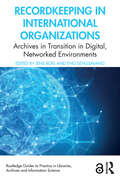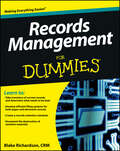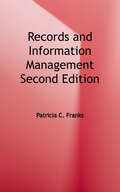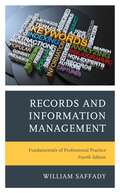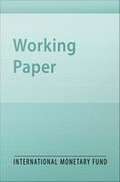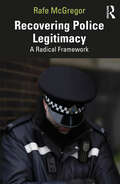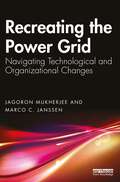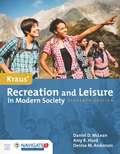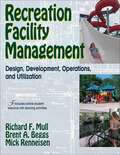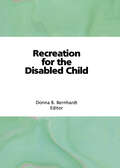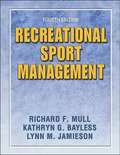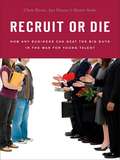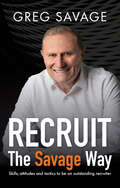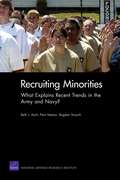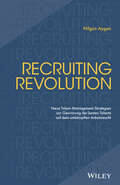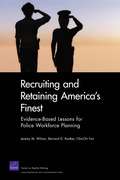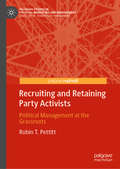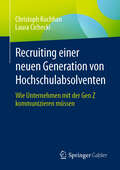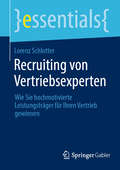- Table View
- List View
Recordkeeping in International Organizations: Archives in Transition in Digital, Networked Environments (Routledge Guides to Practice in Libraries, Archives and Information Science)
by Jens Boel Eng SengsavangRecordkeeping in International Organizations offers an important treatment of international organizations from a recordkeeping perspective, while also illustrating how recordkeeping can play a vital role in our efforts to improve global social conditions.Demonstrating that organizations have both a responsibility and an incentive to effectively manage their records in order to make informed decisions, remain accountable to stakeholders, and preserve institutional history, the book offers practical insights and critical reflections on the effective management, protection, and archiving of records. Through policy advice, surveys, mind mapping, case studies, and strategic reflections, the book provides guidance in the areas of archives, records, and information management for the future. Among the topics addressed are educational requirements for recordkeeping professionals, communication policies, data protection and privacy, cloud computing, classification and declassification policies, artificial intelligence, risk management, enterprise architecture, and the concepts of extraterritoriality and inviolability of archives. The book also offers perspectives on how digital recordkeeping can support the UN’s 2030 Agenda for Sustainable Development, and the accompanying Sustainable Development Goals (SDGs).Recordkeeping in International Organizations will be essential reading for records and archives professionals, information technology, legal, security, management, and leadership staff, including chief information officers. The book should also be of interest to students and scholars engaged in the study of records, archives, and information management, information technology, information security, and law.Chapters 7 and 9 of this book are freely available as a downloadable Open Access PDF at http://www.taylorfrancis.com under a Attribution-NonCommercial-ShareAlike (CC-BY-NC-SA) 4.0 license
Recordkeeping in International Organizations: Archives in Transition in Digital, Networked Environments (Routledge Guides to Practice in Libraries, Archives and Information Science)
by Jens Boel and Eng SengsavangRecordkeeping in International Organizations offers an important treatment of international organizations from a recordkeeping perspective, while also illustrating how recordkeeping can play a vital role in our efforts to improve global social conditions. Demonstrating that organizations have both a responsibility and an incentive to effectively manage their records in order to make informed decisions, remain accountable to stakeholders, and preserve institutional history, the book offers practical insights and critical reflections on the effective management, protection, and archiving of records. Through policy advice, surveys, mind mapping, case studies, and strategic reflections, the book provides guidance in the areas of archives, records, and information management for the future. Among the topics addressed are educational requirements for recordkeeping professionals, communication policies, data protection and privacy, cloud computing, classification and declassification policies, artificial intelligence, risk management, enterprise architecture, and the concepts of extraterritoriality and inviolability of archives. The book also offers perspectives on how digital recordkeeping can support the UN’s 2030 Agenda for Sustainable Development, and the accompanying Sustainable Development Goals (SDGs). Recordkeeping in International Organizations will be essential reading for records and archives professionals, information technology, legal, security, management, and leadership staff, including chief information officers. The book should also be of interest to students and scholars engaged in the study of records, archives, and information management, information technology, information security, and law.
Records Management For Dummies
by RichardsonHere's what you should know to manage data records efficientlyWith proper electronic data management, your business can lower costs, improve efficiency, eliminate duplication, and be protected in the event of a lawsuit. This book provides an overview of records management solutions and implementation strategies in plain, non-technical English. Step-by-step instructions show you how to begin managing records and information and how to maintain the program once you have it established. Sample forms for inventory, scheduling, and necessary documentation are also available on the companion website.Electronic records management offers cost savings, greater efficiency, and protection in case of legal action; this book gets you started on an effective data management systemThis plain-English guide helps you determine what constitutes a record, shows you how to inventory records and create an efficient way to file both electronic and paper copies, and explains how to create a retention scheduleWalks you through switching to electronic record-keeping, what to look for in a records management system, implementing best practices, ensuring that your system will stay current, and using the system effectivelyHelps you assure that the destruction of any sensitive information is conducted and documented correctlyRecords Management For Dummies helps your business save money and improve efficiency with effective electronic records management.
Records and Information Management
by Patricia C. FranksAs Information Management put it, "On the strength of its currency and coverage alone, Franks' book is poised to take over as the recommended go-to reference for both students and RIM professionals for many years to come." <p><p>The new second edition cements this work's status as an up-to-date classic, its content updated and expanded to address emerging technologies, most notably blockchain, and evolving standards and practices. Inside, Franks presents complete coverage of the records and information lifecycle model, encompassing paper, electronic (databases, office suites, email), and new media records (blogs, chat messages, and software as a service). <p><p>Informed by an advisory board of experts in the field and with contributions by noted authorities, the text addresses such key topics as the origins and development of records and information; the discipline of information governance and developing a strategic records management plan; creation/capture and classification; retention strategies, inactive records management, archives, and long-term preservation; access, storage, and retrieval; electronic records and electronic records management systems; the latest on rapidly evolving technologies such as web records, social media, and mobile devices; vital records, disaster preparedness and recovery, and business continuity; monitoring, auditing, and risk management; and education and training. <p><p>This book's authoritative blend of theory and practice makes it a matchless resource for everyone in the archives and records management field. Instructor/trainer extras include a set of ready-to-go, customizable PowerPoint slides to accompany the text.
Recoveries in the Middle East, North Africa, and Pakistan: Have Macroeconomic Policies Been Effective?
by Dalia S. Hakura Francesco GrigoliA report from the International Monetary Fund.
Recovering Police Legitimacy: A Radical Framework
by Rafe McGregorTransatlantic policing is experiencing an unprecedented crisis of legitimacy, epitomised by public responses to the murders of George Floyd and Sarah Everard during the COVID-19 pandemic. Legitimacy is lost when the police either fail to protect the public or rely on coercion rather than consent to achieve that protection. Recovering Police Legitimacy challenges conventional criminological, political, and public solutions to the problem by approaching it from the bottom up, beginning with policing as a practice constituted by a unique set of excellences, skills, and characteristics.The author draws on his experience as a police officer and on the serial fictions of James Ellroy, David Peace, and Nic Pizzolatto to characterise the practice in terms of heroic struggle, edgework, absolute sacrifice, and worldmaking. These characteristics provide an analytic tool for revolutionising our understanding of the relations among policing as a situated practice, public protection, and police legitimacy and for identifying the different levels at which legitimacy is undermined. His conclusion is that recovery is possible but will be slow in pace and incomplete in scope.Written accessibly for students, police officers, policymakers, scholars, and anyone with an interest in police legitimacy, this is a groundbreaking study of a pressing social problem.
Recovery Determinants of Distressed Banks: Regulators, Market Discipline, or the Environment?
by Tigran Poghosyan Thomas Kick Michael KoetterA report from the International Monetary Fund.
Recovery Ratios and Survival Times for Corporate Bonds
by Ivailo IzvorskiA report from the International Monetary Fund.
Recovery from Armed Conflict in Developing Countries: An Economic and Political Analysis (Routledge Studies in Development Economics #No.14)
by Geoff HarrisThis comprehensive work examines ways in which developing countries may achieve economic, political and social reconstruction in the wake of armed conflict. International researchers discuss such issues as women and children in the recovery process, refugees and the role of aid, the reintegration of ex-combatants and community-led recovery. Case studies focus upon Afghanistan, Angola, Cambodia, Mozambique, South Africa and Sri Lanka.
Recovery of Disaster Victims: Results of Joint Survey in East Japan, Aceh, Sichuan, and Tacloban (Kobe University Monograph Series in Social Science Research)
by Yuka Kaneko Jianping Wang Teuku Alvisyahrin Taqwaddin Bin Muhammad Husin Ebinezer R. FloranoThis book presents the results of a joint survey conducted as of the tenth anniversary of the 2011 East Japan Earthquake, by an international research collaboration consisting of researchers representing the major universities affected by recent mega-disasters in Asia, namely, the research group at Kobe University, Japan which has folllowed up ten year recovery process from the 2011 tsunami disaster in East Japan, the research group at the Graduate Program in Disaster Science, Syiah Kuala University in Aceh, Indonesia on the long-term recovery of 17 years after the 2004 Indian Ocean Tsunami, the research group at the Institute for Disaster Management and Reconstruction of Sichuan University, China focusing on the recovery status of 13 years after the 2008 Sichuan (Wenchuan) Earthquake; and the research group at the National College of Public Administration and Governance of University of the Philippines, on the rcovery from the 2013 Typhoon Yolanda that hit the Philippines. The purpose of the survey was to evaluate the status of human life recovery of disaster-affected populations and communities in Asia in the long term, for the ultimate purpose of reviewing and comparing the outcomes of different prioritizations among the plural goals of disaster recovery. Through such a review, the authors intend to induce policy implications to guide a better recovery process with lesser impact on the human life recovery in the future disasters that we humans are destined to meet. The target areas are 16 districts in Iwate and Miyagi prefectures in Japan, all typical areas seriously affected by the 2011 tsunami and subsequently came under the governmental construction works for the safety, as well as three villages in Banda Aceh and its outskirts in Aceh Special Province, Indonesia,; two districts in Mianyang city in Sichuan, China which were targetted by intensive reconstructon works conducted by the coupling assistance; and two village communities in Tacloban, the capital city of Leyte island hit by the 2013 Typhoon Yolanda. To realize the concurrent attainment of both safety and livelihood in the recovery planning, this joint survey has identified common issues for a successful cooperation between the local government and communities through the inclusive participation of various institutions representing the variety of interests in each community.
Recreating the Power Grid: Navigating Technological and Organizational Changes
by Jagoron Mukherjee Marco C. JanssenThis book helps power industry executives to systematically navigate the complex technological and organizational changes necessary to recreate power grids. This is especially pertinent in the current environment characterized by volatility, uncertainty, complexity, and ambiguity conditions. Across the globe, the electric power sector is facing many forces of change as it transitions from a fossil-based system to cleaner sustainable resources. Leaders in the power sector face unprecedented challenges in responding to these changes while continuing to provide safe, reliable, clean, and affordable electricity. Recognizing that historical and existing ways will not work, Jagoron Mukherjee and Marco C. Janssen present a new paradigm for industry leaders to tackle some of the key questions to determine the best path forward: What will the business be like in the future? What technologies will likely prevail? How should my company respond to constant change? How expensive will the transition be? Will the customer expectations be met? How fast do we need to change? Drawing on well-known management principles, the book helps industry leaders to provide a methodology to tackle these questions and sharpen their decisions as they embrace innovation, new customer expectations and digitization in their efforts to steer the energy transition. Taking a holistic problem-solving approach, which addresses the power company as a whole, Recreating the Power Grid will be a valuable resource for all professionals working in this quickly evolving field.
Recreation And Leisure In Modern Society
by Amy Hurd Daniel McLean Denise M. AndersonEach new print copy includes Navigate 2 Advantage Access that unlocks a comprehensive and interactive eBook, student practice activities and assessments, a full suite of instructor resources, and learning analytics reporting tools. Reorganized and streamlined to enhance learning outcomes, the eleventh edition of Kraus' Recreation and Leisure in Modern Society provides a detailed introduction to the history, developments, and current trends in leisure studies. The Eleventh Edition focuses on the challenges and opportunities impacting the profession--including dramatic demographic changes, new technologies, and innovations in marketing--through an array of pedagogical features, including engaging sidebars and case studies addressing contemporary issues. Focusing on the ten different types of organizations--ranging from nonprofit community organizations and armed forces recreation to sports management and travel and tourism sponsors--the Eleventh Edition is an invaluable resource for students considering a career in the recreation and leisure industry. With Navigate 2, technology and content combine to expand the reach of your classroom. Whether you teach an online, hybrid, or traditional classroom-based course, Navigate 2 delivers unbeatable value. Experience Navigate 2 today at www.jblnavigate.com/2.
Recreation Facility Management: Design, Development, Operations And Utilization
by Richard F. Mull Brent A. Beggs Mick RenneisenRecreation facility management is a complex responsibility. Professionals in this field are responsible for various types of facilities—recreation centers, water parks and pools, playgrounds, parks, fitness centers, sport complexes, and resorts—each with its own set of goals and challenges. Recreation Facility Management: Design, Development, Operations, and Utilization provides students and new professionals with a basic understanding of recreation facilities and prepares them to perform the duties required of a recreation facility manager. Part I of Recreation Facility Management offers a detailed look at the foundations of the profession, including the defining characteristics of recreation facility management and descriptions of the duties of a recreation facility manager and the areas within the facilities. Also featured are descriptions of the common indoor and outdoor elements of facilities, including sites, spaces, lighting, surfaces, utilities, landscaping, walkways, and parking areas. The remaining parts of the book detail the practical knowledge and skills as well as tasks and processes required for managing various types of recreation facilities. Readers will find these features: A thorough discussion of the facility design and development process, including needs assessment, planning, reading blueprints, funding, the bid process, and construction Information on managing facility resources, including equipment; financial issues, such as budgeting, taxes, fees and charges, and donations; and human resources, including hiring, training, and evaluating employees A detailed examination of facility utilization, including safety and security, scheduling, maintenance, and emergencies and emergency response A review of parks, playgrounds, aquatic facilities, and ancillary spaces, including parking areas, showers and restrooms, and child care areas Coverage of national industry standards and guidelines for various types of facilities Throughout the book readers will find examples from settings in recreation, leisure, parks, and tourism that will help them apply their knowledge to various types of recreation facilities. Recreation Facility Management also includes access to an online student resource (OSR) that will help students tie the information in the book to practical matters on the job. The OSR contains learning activities, forms from the files of actual facility managers, worksheets, and Web links to help students further explore the ideas found in the book. Recreation Facility Management offers a practical introduction to facility design, management, and maintenance for practicing or future recreation professionals. This resource provides the knowledge and skills necessary for becoming a successful facility manager in any recreation setting.
Recreation for the Disabled Child
by Donna Bernhardt BainbridgeThis valuable book deals with the recreation activities for the disabled, including skiing, horseback riding, running, camping, water sports, and team sports. Experts examine competitive spirit, training, and the psychological benefits of recreational activities for the disabled child. Program development, evaluation, and instruction are discussed.
Recreational Sport Management
by Lynn M. Jamieson Richard F. Mull Kathryn G. BaylessThrough Recreational Sport Management, Fourth Edition, you can do the following: -Acquire the foundational knowledge, concepts, and real-world applications to succeed in the field of recreational sport management. -Learn the keys to managing a variety of program delivery systems. -Use more than 60 forms and checklists to ensure smooth day-to-day operations. Recreational Sport Management, Fourth Edition, is back and stronger than ever. This new edition of a classic text has been significantly expanded and improved to keep students up to date in recreational sport management practices and prepare them for solid careers in the field. It also is a practical tool for professionals already working in the field. This latest edition continues to provide comprehensive coverage of the concepts and applications of effective recreational sport programming and administration. And it provides an even broader view of recreational sport management in various settings as well as guidance in professional changes and issues that have surfaced since the previous edition was published. This latest edition includes the following: -New chapters on facility management, equipment, and maintenance -A new chapter on career implications, which offers practical guidance to students pursuing careers in recreational sport management -Expanded chapters on a developmental approach, fitness, informal sport, planning, and finance -A new management model
Recruit or Die
by Chris Resto Ian Ybarra Ramit SethiA guerrilla guide to getting the best college graduates to work for you--without spending like Microsoft, McKinsey, and Goldman Sachs Recruit or Die is the first practical guide to the entry-level recruiting game--which is very different from other kinds of recruiting and vitally important to every company, large or small. Traditionally, only large and powerful companies recruit on college campuses, scooping up the best and brightest. But small and young companies can also get top graduates--without a Wall Street budget--if they learn the secrets of America's top recruiters. The key is understanding today's college students: They aren't just looking for money and perks. More important, they are looking for opportunities to stand out, move around quickly, and rack up cool experiences and achievements. Any employer can compete with the big companies on these intangibles. The authors share dozens of anecdotes and research on more than one thousand students that show how successful recruiters work their magic--and how unsuccessful recruiters blow it. They offer practical strategies and advice in each chapter, along with case studies. Based on their experience working with hot recruits and the elite companies that pursue them, the authors show how any company can conquer the campus.
Recruit – The Savage Way: Skills, attitudes and tactics to be an outstanding recruiter
by Greg SavageWorking in the recruitment industry is challenging. Few recruiters survive two years in the business, and fewer still turn recruiting into a lifelong career. RECRUIT is a one-stop shop that will inspire readers to do the work and teach them how to develop the skills and mindset that will bring success in the form of a fun and fulfilling career, as well as financial gain. RECRUIT comprises 128 micro-chapters grouped into 6 parts that cover:1.attitude and mindset2.behaviour and activity3.selling by listening4.candidate skills5.client skills6.developing your recruitment careerGreg Savage' s advice is based on 44 years in recruitment. He takes a direct, no-nonsense approach and combines storytelling, humor and proven practical advice.A career in recruitment, as in any industry, will be a journey of constant improvement, learning, upskilling, growth and evolution. Keep RECRUIT as your constant companion as you develop the skills, attitudes and tactics necessary to become an outstanding recruiter.
Recruiting Minorities: What Explains Recent Trends in the Army and Navy?
by Bogdan Savych Paul Heaton Beth J. AschSince 2000, black representation among high-quality recruits in the Army has decreased, while Hispanic representation has increased; in the Navy, black representation has remained stable and Hispanic representation has increased. The authors identify factors that explain these trends and consider which policies are likely to be most effective in increasing high-quality enlistments among black, Hispanic, and white youth.
Recruiting Revolution: Neue Talent-Management-Strategien zur Gewinnung der besten Talente auf dem umkämpften Arbeitsmarkt
by Nilgün AygenDas Buch von Nilgün Aygen stellt einen innovativen Ansatz, eine zukunftsweisende Weltanschauung dar, die den Rekrutierungsprozess des Unternehmens auf neue Beine stellt. Nach der Devise "Die Wege von heute führen nicht ins Morgen" verlangt es ein verändertes Mindset vom Top- und HR-Management der Unternehmen. So wie es aktuell praktiziert wird, tritt das Unternehmen primär als Einkäufer von Arbeitskraft und Arbeitskräften auf. Zwar präsentiert es sich als attraktiv für Bewerber, doch die Maà nahmen und Werkzeuge sind passiv orientiert. Auf diese Weise vorzugehen, um die besten Talente zu gewinnen ist reaktiv statt proaktiv und rein operational statt strategisch. Um in Zukunft jedoch die besten Talente gewinnen zu können und bei Bedarf umgehend verfügbar zu haben, müssen die Unternehmen sich als Arbeitgeber aktiv verkaufen. In der Unternehmensstrategie gehören die HR-Leitungen mit an den Vorstandstisch. Eine weitere, ebenso bedeutsame Botschaft des Buchs lautet, dass viele Organisationen ihre aktuellen Talente vergeuden, weil sie bei akutem Bedarf reflexhaft nach externen Möglichkeiten zur Stellenbesetzung suchen. Sie verschwenden Talent - nicht aus bewusster Geringschätzung ihrer existierenden Mitarbeiter, sondern aus der Ahnungslosigkeit heraus, welches Potenzial intern vorhanden ist. Das Buch fordert aber nicht nur das nötige Umdenken und neue Handeln ein, sondern beschreibt von der ersten Recherche über die Einstellung bis zur vollständigen Integration des neuen Mitarbeitenden alles, was Unternehmen heute und künftig tun müssen, um im Arbeitsmarkt der Zukunft den gröà ten Schatz zu finden und zu gewinnen: die wertvollen Menschen, mit denen sie ihre Visionen und Ziele erreichen können. Die vielfältigen Beispiele und Case Studies weisen den wirtschaftlichen Erfolg einer neuen Art des People Managements nach und zeigen, wie sehr es Menschen dabei unterstützt, ein erfülltes Arbeitsleben zu haben.
Recruiting and Retaining America's Finest: Evidence-based Lessons for Police Workforce Planning
by Bernard D. Rostker Jeremy M. Wilson Cha-Chi FanShares results of a survey, sent to every U.S. police agency with at least 300 sworn officers, on recruitment and retention practices. Finds that police compensation, city size, and crime rates affected recruiting. Advertising and incentives had little effect on the number of recruits. Cohort sizes highlighted management challenges. To facilitate comparative and longitudinal staffing analyses, ongoing national data collection is recommended.
Recruiting and Retaining Party Activists: Political Management at the Grassroots (Palgrave Studies in Political Marketing and Management)
by Robin T. PettittThis book explores how experienced party organisers in the UK work to recruit and to retain party activists for local campaigning. Local door-to-door campaigning is widely regarded as being a key element in a successful election campaign. However, for door-to-door campaigning to work, a large number of volunteer activists are required. The question then is: How can parties identify, recruit and retain such volunteer activists? Based on interviews with highly experienced campaigners, original party documents, the wider campaigning and volunteering literature, numerous informal conversations and the author’s own experience of local campaigning over a 20 year period, this book provides an answer to that question. It shows how potential activists are identified, encouraged to become active and supported through their initial encounter with local campaigning. The author also shows how local parties can encourage activists to remain active by creating a ‘retention enhancing campaigning environment’ and what that involves.
Recruiting at Bowles Hollowell Conner & Co.
by Herminia Ibarra John P. Kotter John J. Gabarro Andrew BurtisExamines the recruiting process of Bowles Hollowell Conner & Co. (BHC), an investment banking firm known for its work with middle market companies. Specifically, presents a profile of the firm and its recruiting process and then examines that process through the firm's recruiting efforts at Harvard Business School (HBS). Includes the resumes of 17 second-year HBS students who sought interviews for an associate position with BHC and raises the issue of how interview selections were made from those resumes.
Recruiting einer neuen Generation von Hochschulabsolventen: Wie Unternehmen mit der Gen Z kommunizieren müssen
by Christoph Kochhan Laura CicheckiDieses Buch geht der Frage nach, wie Unternehmen Hochschulabsolventen aus der Generation Z gezielt ansprechen können, um sie als Mitarbeitende zu gewinnen. Die um die Jahrtausendwende geborene Gen Z gilt als idealistisch und durch Haltung getrieben, zuweilen aber auch als wählerisch, unmotiviert und sprunghaft; ein Job fürs Leben ist nur für die wenigsten der aktuellen Absolventen vorstellbar. Unternehmen müssen jedoch weiterhin Nachwuchs rekrutieren, um erfolgreich und produktiv zu bleiben, – aber sind sie auf die neuen Vorstellungen und Ansprüche der Gen Z vorbereitet? Das Autorenteam beantwortet in diesem Buch auf Basis einer umfassenden qualitativen Studie mit Studierenden und Unternehmensvertretern in der DACH-Region folgende Fragen: Wie erreichen Arbeitgeber die neue Generation der Hochschulabsolventen? Was macht erfolgreiches Personalmarketing in der Praxis heutzutage aus? Und: Wie wird sich die Arbeitswelt weiterentwickeln? Außerdem: Jo Dietrich, Co-Founder der Gen-Z-Agentur ZEAM, erläutert im Interview, wie Arbeitgebermarken für die Gen Z attraktiv werden, und gibt Praxistipps für u. a. Recruiting, Bewerbungsprozess sowie Social-Media-Auftritt.
Recruiting von Vertriebsexperten: Wie Sie hochmotivierte Leistungsträger für Ihren Vertrieb gewinnen (essentials)
by Lorenz SchlotterAls Vertriebsleiter, Geschäftsführer oder HR-Manager kennen Sie die Herausforderung: Sie möchten leistungsstarke Vertriebsexperten für Ihr Unternehmen gewinnen, doch bisher gelingt es nicht, passende Kandidaten zu finden oder diejenigen, die Sie finden, verfügen nicht über die nötige Leistungsmotivation. In diesem essential lernen Sie ein Konzept kennen, das Ihnen hilft, dieses Problem zu lösen und systematisch einfacher Leistungsträger für Ihren Vertrieb zu gewinnen.
